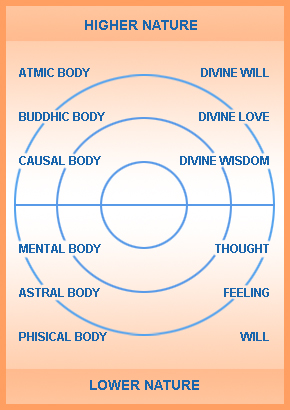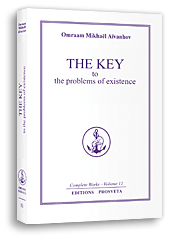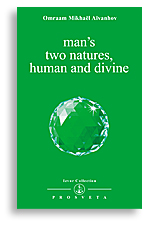Our two Natures
 ‘For thousands of years, in their attempts to study their own nature and to understand the principle elements that make up the whole, human beings have elaborated a number of different ways of explaining man’s manifold being. Some see man as two-fold (good and evil, higher and lower, spirit and matter, masculine and feminine, heaven and earth). Others divide man into three (thought, feeling and will, which corresponds to the Christian description of man as body, soul and spirit). The alchemists divided the human being into four, in reference to the four elements. Astrologers divide humans into twelve, in accordance with the twelve constellations. Hindus and Theosophists teach that man has seven bodies: physical, etheric, astral, mental, causal, buddhic and atmic. Cabbalists divide man into three or four, or into nine or ten parts. And finally, for others, the human being is an indivisible whole. Whichever system one adopts, it is always true; it simply depends on one’s point of view.
‘For thousands of years, in their attempts to study their own nature and to understand the principle elements that make up the whole, human beings have elaborated a number of different ways of explaining man’s manifold being. Some see man as two-fold (good and evil, higher and lower, spirit and matter, masculine and feminine, heaven and earth). Others divide man into three (thought, feeling and will, which corresponds to the Christian description of man as body, soul and spirit). The alchemists divided the human being into four, in reference to the four elements. Astrologers divide humans into twelve, in accordance with the twelve constellations. Hindus and Theosophists teach that man has seven bodies: physical, etheric, astral, mental, causal, buddhic and atmic. Cabbalists divide man into three or four, or into nine or ten parts. And finally, for others, the human being is an indivisible whole. Whichever system one adopts, it is always true; it simply depends on one’s point of view.
To simplify the matter, let’s say that a human being is a perfect whole, but that this whole is polarized. In other words, it manifests in two directions, as two different aspects. The human being is composed of two natures: a lower nature (which we will call the lower self, or personality) and a higher nature (which we will refer to as the higher self, or individuality). They both have the ability to think, feel and act, but in opposite directions. The best way to see this clearly is to observe oneself, but most human beings get everything mixed up: for them their inferior thoughts and feelings are of the same nature as their higher thoughts and feelings; they are unable to distinguish one from another. But for initiates, the difference is absolutely clear. In reality, one cannot distinguish a perfectly clear borderline between the two because they blend into each other like the colors of the spectrum (from afar the different colors can be clearly distinguished, but seen from close up it is impossible to tell exactly where one ends and the next begins). But in day to day life they can easily be distinguished.’
The manifestation of our two natures
 ‘Above all, the personality wants to show itself off and is ready to go to any lengths, pleasant or otherwise, to do so. It will wear garish colors and eccentric clothes, drawing attention to itself with loud, grotesque laughter and affected mannerisms. It is always trying to seem more important than it really is, like a hen that fluffs out its feathers to appear twice its size. But most important, it is extremely fickle and changes from one mood to another with incredible ease: in turn it will be gay, then sad; optimistic, then discouraged; kind, and then cruel. It is afraid of hunger, poverty and death and goes to incredible lengths to ensure that it will always have enough to eat and all kinds of possessions. But it is incapable of holding onto anything, because it is a bottomless pit into which everything vanishes. The personality knows only one motivation: self-interest, and to ensure this, it is capable of changing its philosophy, its religion or its political opinions as readily as circumstances require.
‘Above all, the personality wants to show itself off and is ready to go to any lengths, pleasant or otherwise, to do so. It will wear garish colors and eccentric clothes, drawing attention to itself with loud, grotesque laughter and affected mannerisms. It is always trying to seem more important than it really is, like a hen that fluffs out its feathers to appear twice its size. But most important, it is extremely fickle and changes from one mood to another with incredible ease: in turn it will be gay, then sad; optimistic, then discouraged; kind, and then cruel. It is afraid of hunger, poverty and death and goes to incredible lengths to ensure that it will always have enough to eat and all kinds of possessions. But it is incapable of holding onto anything, because it is a bottomless pit into which everything vanishes. The personality knows only one motivation: self-interest, and to ensure this, it is capable of changing its philosophy, its religion or its political opinions as readily as circumstances require.
The individuality conducts itself in a way diametrically opposed to that of the personality. It isn't eager to show itself off; it never tries to dazzle or deceive and doesn't call attention to itself with loud talk, because it knows it will be noticed when necessary. In the meantime, it relies on its talents and its own hard work. Rooted deeply in the individuality is a steady, unshakeable conviction together with a steadfast and lasting hope and faith. It never wavers; its point of view is always the same.’
‘Unfortunately, most people rely far too much on their personalities, looking to their lower nature for freedom, happiness and enlightenment. No, with the personality one finds only weakness on the physical plane, suffering on the astral plane and error on the mental plane. In spite of its seductive ways, this is all the personality can offer. It resembles a soap bubble: it takes flight, shimmering and iridescent, and soon bursts.’
‘ All our faults and weaknesses have their roots in the personality. This is why it is useless to concern yourself with your faults, because to correct even one of them could take an entire lifetime, and even longer! Far better to concern yourself with their roots, with the personality which is what feeds them and keeps them alive. The personality is characterized by egotism. Those who are ruled by their personality care only for themselves; no one else counts for them. They consider themselves the center of the universe, and the whole world is there to please them, to revolve around them, to look on them with love and cater to their every wish.’
All our faults and weaknesses have their roots in the personality. This is why it is useless to concern yourself with your faults, because to correct even one of them could take an entire lifetime, and even longer! Far better to concern yourself with their roots, with the personality which is what feeds them and keeps them alive. The personality is characterized by egotism. Those who are ruled by their personality care only for themselves; no one else counts for them. They consider themselves the center of the universe, and the whole world is there to please them, to revolve around them, to look on them with love and cater to their every wish.’
‘The higher self, on the contrary, wants only to enlighten, to shine, to give, to help and support others. It thinks only of offering something of itself, out of generosity and selflessness. That is why it doesn’t hide its possessions and isn’t irritated when someone wants to take from it. On the contrary, it is happy to give people what they need: food and drink and light. The individuality is also a trinity where the intellect, heart and will manifest; the desire of the intellect is to shine, the desire of the heart is to shed warmth, and the desire of the will is to vivify them and set them free. The fundamental virtue of the higher nature is selfless giving.’
![]() The two natures of the human being, the personality and the individuality
The two natures of the human being, the personality and the individuality



